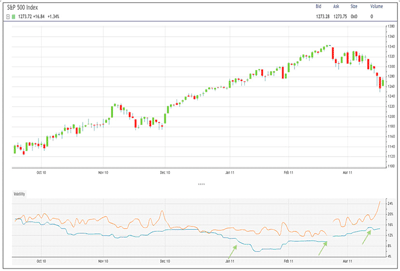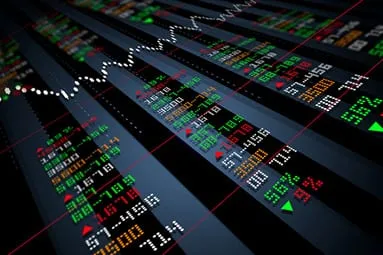Analyzing options-related measures like volatility can give important clues about the health of the overall market and individual stocks.
When I first began trading professionally in the options markets about 16 years ago, I thought I knew it all. I understood all the theory and mathematics that went into finding the price of an option, how the exchange system worked (or was supposed to work), etc. You see, as a young trader on the floor, I had to at least act as such, or I was bound to be prey for the traders who had spent a quarter century there before me.
The truth is, I didn’t really have the wisdom that many of the best options traders in the world have. Anyone can have a “good trade;” in fact, some have a string of trades that may even propel them into wealth to some extent. But I have learned that to have longevity, aside from some luck, it takes not only skill, but the ability to look a little deeper into yourself and the markets. Today, I’ll focus on the latter.
More to the Numbers
I have spent most of the week in Nicaragua (which is a remarkable, beautiful country, by the way) with some of our clients. None of them are option traders, but all of them have similar basic reasons and methods for getting into a stock or other investment, and most have been successful at doing so. But after several conversations, I hopefully convinced them to learn more about options, but more importantly, to mitigate the profit-and-loss volatility of their investment portfolios, which seems to be a popular theme amongst all investors.
When most of us look at a stock—or any investment, for that matter—we look at its cost, fundamental data, and maybe some technical formations, and after some research, we make a decision to buy or sell. This method is common and has made many successful. But as my good friend Mark Douglas says, there is a huge “profit gap.” A profit gap is the potential you can make in your investing and what you actually end up making.
What many of us fail to look at is the “volatility” of that investment. In other words, we forget to ask what the typical percentage gain or loss over a year’s time may be.
I know math scares the “you know what” out of most people, but it doesn’t have to be that hard. Understanding how volatile an investment is not only can save you the cost of Pepto Bismol, it can save you real cash, help you set realistic profit targets and stop losses, and shrink your profit gap!
What Is the Volatility of a Stock?
To make this explanation straightforward, I will keep this simple.
There are two types of stock volatility:
- Historical volatility (also called observed volatility) is a measurement of how much a stock or investment fluctuates in price over a certain period of time
- Implied volatility (AKA “IV;” figured from option prices) tells us how much of a fluctuation the options are anticipating in the future based on their price
Both types are expressed in annual percentage terms. So if I said that the observed volatility of International Business Machines (IBM) is 20%, this means that IBM is moving both up and down at about a 20% annual rate over the past year (or other duration).
*NOTE: This would also mean that the annual standard deviation for IBM is $20, for all you math geeks.
You can simply observe the movements over a period of time to figure this out. You don’t have to do the math yourself; most brokers actually have this data available in a chart or otherwise. Ask them!
This measurement helps professional and retail traders to set realistic expectations for stop losses and profit targets.
Assume you bought IBM at $100 and its observed volatility is 20%. What do you think the chances of it getting to $140 in a year’s time are? Probably slim!
What if you bought IBM for a long-term trade (over a year) and you placed a stop loss at $95. What do you think the chances of getting stopped out prematurely are? Probably high!
Can you see how it helps to look at the volatility of a stock before you set targets and stops?
What Options Tell Us
At this point, some or all of you may be about to hit the back button on your browser and move on, but I implore you to read further and pay attention to this.
You see, the “smart money,” as it’s often called, uses options to hedge their bets (on stocks) and also to make predictions about a stock’s future movement, especially over earnings or news releases. When they are buying or selling options, they are moving implied volatility up or down!
Looking at an option’s implied volatility can tell you much about what the smart money is thinking. Let me be the first to tell you that they are not always right, but they tend to have much more skin in the game and have huge budgets for research (and friends). They make it their business to be right more than they are wrong.
Just about every options broker out there displays an option’s implied volatility in the “option chain.”
Let’s look at real S&P 500 volatility and options this time.
Looking at the chart below, price is on top, and volatility is on the bottom (blue is observed, orange is implied). When there not only is a spike in implied volatility, but it starts to gap way above historical, I start to wonder what is going on.
Back in January, we saw this gap widen and the market seemed unstoppable, but the option markets saw differently. Sure enough, we had some small corrections. The gap got wide in mid February and again about a week ago, which is why I wrote in a recent article that I thought the market could see more selling.
Right now, implied volatility still remains elevated; options markets are predicting movement of about 1.4% per day in the S&P 500 about two out of every three days for the next couple of months.
If this article has got you thinking, this is only the tip of the iceberg. Learn the option markets and what they can tell you. I’m not saying they are a crystal ball—they’re more like a canary.
By Jared Levy, editor, WaveStrength Options Weekly

















